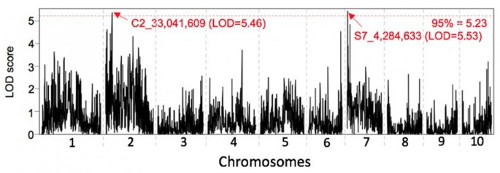By Yang Yen

Topsoil and nutrient runoff are two serious challenges of sustainable agriculture. Perennial crops can help solve these problems by preserving cropland productivity without requiring substantial dietary and manufacture shifts. Although the development of perennial corn has long been an idea, a major roadblock has been the lack of knowledge about the genetics of perennialism. SDSU researchers Drs. Yang Yen and Donald Auger have been working on this problem. Agricultural corn is annual but it has two wild relatives that are perennial. The wild relatives of corn are called teosinte. With the help of Dr. Auger, Dr. Yen’s group is studying the genetics of one of these perennial teosintes, Zea diploperennis. Previous genetic studies have yielded contradictory results. Because of this, Dr. Yen’s group have taken a reductionist approach and focused on a single trait: regrowth of a new plant from the base of a plant that has senesced. Senescence refers to the dieback that occurs after corn has flowered and set seed. To address this problem, six hybrids were made by reciprocally crossing the perennial teosinte with corn lines B73, Mo17 and Rhee Flint, an heirloom variety. All hybrid plants demonstrated several cycles of flowering, senescence and regrowth, indicating that the factors for regrowth are genetically dominant. The pattern of transmission of this trait to progeny from crosses and self-pollinations indicate two dominant, complementary genes, which in turn are influenced by other genetic factors or environment. Genome-wide screening with genotyping-by-sequencing technology also revealed two major regrowth factors, regrowth 1 (reg1) and regrowth 2 (reg2), on chromosomes 2 and 7, respectively. These findings lay the foundation for further exploration of the molecular mechanism of regrowth inperennial teosinte. Importantly, their data indicate that there is no major barrier to transferring this trait into maize or other grass crops for perennial crop development. This could enhance sustainability of grain crop production in an environmentally friendly way.
Click here to see more...